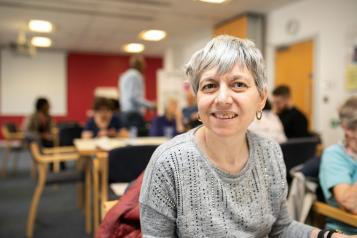Accessible information: A necessity, not a luxury

Whether it's a hospital appointment, medical advice, or details about a procedure, accessible information is crucial for ensuring everyone can manage their health independently and with dignity.
Yet, for many individuals, accessing healthcare information in a format they can understand is still a struggle.
This article explores why accessible information matters, the current situation in North Yorkshire, and what needs to change to improve the lives of people with disabilities.
The importance of accessible information
Accessible information means providing details in a way that everyone can understand, regardless of their disability. For some, this might mean information in large print or braille, for others, it might mean using easy-to-read language or having access to British Sign Language interpreters. Without this, many people struggle to get the information they need to manage their healthcare effectively.
As one with sight impairment from North Yorkshire explains:
"Since I was diagnosed with a sight impairment, I have had to fight for large print format. It’s taken two years and three letters to chief executives before I largely succeeded, but it’s still hit and miss."
Despite legislation like the Equality Act 2010 and the earlier Disability Discrimination Act (1995), which require public services to make reasonable adjustments for people with disabilities, many individuals still find it difficult to receive information in their preferred format. One person asks:
"Why is being disabled so difficult in the 21st century, 28 years after the introduction of the Disability Discrimination Act?"
The local picture in North Yorkshire
In 2021, across Yorkshire and the Humber, there were about 154,300 people with a learning disability according to Yorkshire Public Health, alongside many others who have physical disabilities or sensory impairments. It is estimated that in 2026 this will rise to 161,500 people.
Healthwatch North Yorkshire has heard that people with disabilities continue to face barriers when trying to access healthcare information.
Healthwatch England's previous work showed that 28% of people with hearing, sight or learning disabilities said they had been refused help when requesting accessible information from the NHS.
Locally, two thirds of people in North Yorkshire told us that they had never been asked if they needed information in a different format. 59% had to rely on someone else to read information to them if it was sent in the wrong format. People said they were frustrated with the situation and felt their independence had been taken away.
One person, who is profoundly deaf, shared their frustration:
"For seven months I’ve found it difficult to get a GP appointment. I’m always offered a phone call appointment, but I’m deaf. It’s not a good way to communicate. Despite talking to my GP about it, the same problem remains."
This issue highlights a lack of awareness among healthcare providers about alternative communication methods. Similarly, many individuals with visual impairments report being sent information in formats they cannot read:
"The hardest thing for me by far is being texted about important things from doctors. I keep telling them I cannot see texts."
These experiences are not isolated. Many people with disabilities find themselves in similar situations where they are denied the right to access information that others take for granted. One person remarked:
"There are issues with leaflets covering hospital procedures or recovery instructions. It’s never considered that the patient might need them in a format they can actually understand."
Real stories from people locally
Struggling for independence
One woman shared her frustration about her husband's experience with healthcare providers:
"My husband is quite capable of managing things for himself if it’s in the right format. It’s very annoying when it isn’t, as I have to help, which is time-consuming and limits his independence."
This highlights how failing to provide accessible information can strip people of their independence and burden their loved ones.
Deafness and GP appointments
Another individual who is profoundly deaf faced challenges with GP appointments:
"I’ve always found it challenging to get a face-to-face appointment. Instead, I’m constantly offered a phone appointment. It’s ridiculous."
Offering phone appointments to someone who is deaf shows a lack of understanding and consideration for their needs.
The Legal framework and gaps in practice
The Equality Act 2010 clearly states that reasonable adjustments should be made for people with disabilities, including providing accessible information. Despite this, many healthcare providers are failing to comply. One person with sight impairment explained:
"You would think that all letters from the eye clinic would be in large print as a default, but that’s not the case."
Some organisations are starting to make changes, but progress is slow. For example, North Yorkshire NHS hospital Trusts have begun offering Video Relay Service for British Sign Language, but many other services are still not fully accessible. As one person put it:
"It’s amazing that in the 21st century these issues still exist. The system doesn’t anticipate that not everyone can use the phone."
What needs to change?
To improve the situation, healthcare providers need to ask one simple question at the start of any process: "What is your preferred way of receiving information?"
This would prevent the repeated frustrations of people having to ask for information in their preferred format. It could also be linked to their NHS number, so the need for accessible information is shared across all healthcare providers. One person suggested:
"Why can’t accessible information needs be linked to your NHS number, so every part of the NHS has the information and can act on it? That would be so much easier."
In addition, staff training is essential to ensure that everyone understands how to make information accessible, whether that means sending large print letters, using plain English, or offering British Sign Language interpreters. As another individual said:
"I would like organisations to have training on how to make things easy-read and accessible for disabled people."
Conclusion
Accessible information is not just a matter of convenience. It’s a legal and moral obligation (known as the Accessible Information Standard) Everyone deserves the right to access healthcare information in a way they can understand, allowing them to maintain their independence and dignity.
By listening to individuals with disabilities and making these simple changes, healthcare providers in North Yorkshire can create a more inclusive and accessible system that meets the needs of everyone in the community. As one person who wisely put it:
"Ask me what helps me, and do something about it."
Learn more about accessible information
The NHS have worked with the charity Sense to develop an animated video below which provides a step-by-step overview of the Standard. The video includes subtitles and British Sign Language interpretation.


